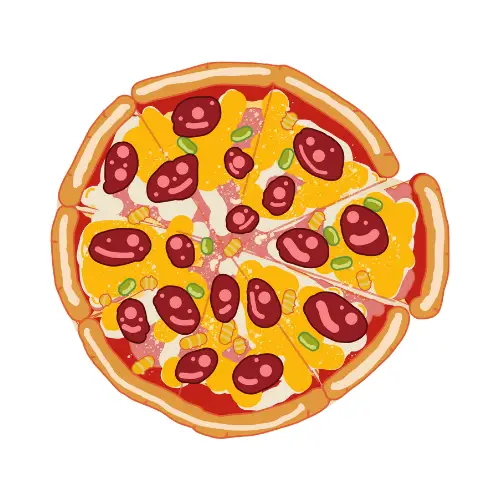It’s hard to find someone who doesn’t love pizza, right? Gluten-free pizza is made for people with gluten intolerance or celiac disease. But does that mean that such pizza would definitely be healthy and wholesome food?
Let’s puzzle over how many calories are in gluten free pizza and how good it is for wellness.

Gluten-free pizza features
Gluten is a type of plant protein that is found in some grains, such as wheat, rye or barley. It is the gluten bonds that make the pizza dough elastic and hold its shape. Thank goodness this is not the only crust recipe, and there are other options for achieving the right consistency.
To avoid gluten, wheat is substituted for another cereal. Flours made from corn, rice, buckwheat, coconut, almonds, oats, flax, amaranth, peanuts, and beans are available. Gluten-free dough usually includes rice or bean flour, tapioca starch, or cornmeal.
Eggs are also added to such pizza dough for protein elastic consistency.
Gluten-free flour
Interestingly, the history of gluten-free flour begins around 2010. Don’t get me wrong, many gluten-free flours were used locally in countries where these grains were traditional. But in 2010, the chefs at Thomas Keller’s restaurants specifically substituted all-purpose flour for gluten-free flour.
Having a neutral flavor, this gluten-free flour does not change the taste of the dish. It is used in the same proportion as regular flour and does not require adjustments to recipes. In fact, that is what it is called, Cup for Cup, that is, 1:1.
Many who follow a gluten-free diet are now saved from having to deny themselves a gastronomic pizza treat.
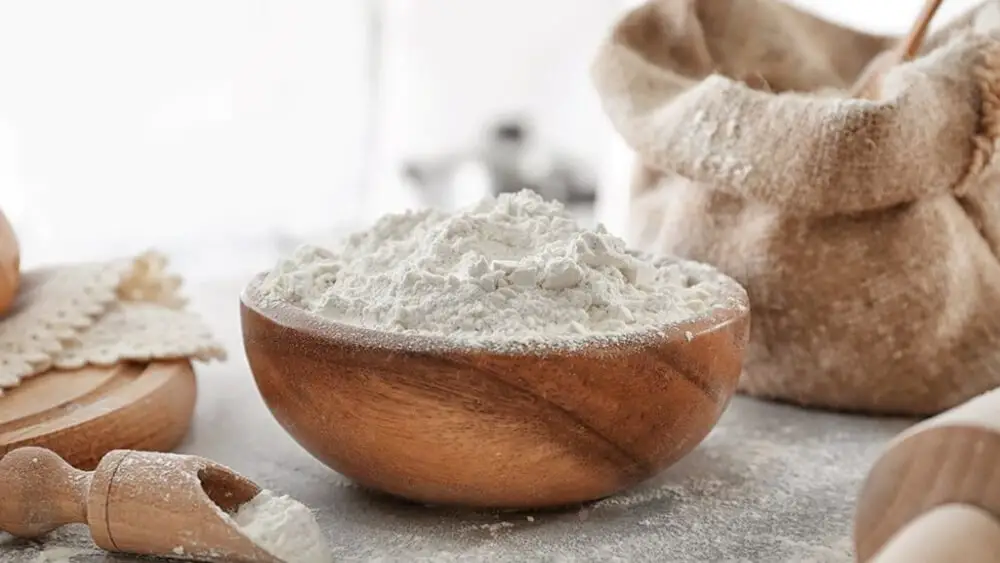
Gluten-free foods trend
Soon after, pizza chains began offering gluten-free pizzas. In 2013, Domino’s became one of the pioneers of the trend, offering diners a gluten-free pizza crust. In 2015, Pizza Hut supported the trend and added fully gluten-free pizza to the menu.
Today, gluten-free pizzas are a must-have, although it’s not easy to get a safety certification mark from the Gluten Intolerance Group. But it’s justified for pizza industry as more and more people around the world are joining the gluten-free diet.
Statistically, about 18 million Americans are sensitive to gluten and they need a lifelong strict diet to avoid harm to their health. And more and more people are claiming that avoiding gluten helps them feel better.
Gluten-free diet
In addition to the gluten-free crust, there is the same requirement for toppings and sauce. To thicken sauces, evaporation rather than the addition of flour should be preferred.
What’s more, pizza restaurants must make sure that regular and gluten-free pizzas do not come into contact with each other in any way. When baking a gluten-free pizza, the stones are lined with parchment and a separate cutter is used for slicing. The clean cut is in demand not only for persons with a celiac disease, but also for persons with allergies and for those with religious or ethical food restrictions.
Most familiar pizza toppings are gluten-free. These include everyone’s favorite pepperoni, chicken, bacon, cheese, vegetables, and mushrooms, seafood. By the way, just look at these mini seafood pizzas.
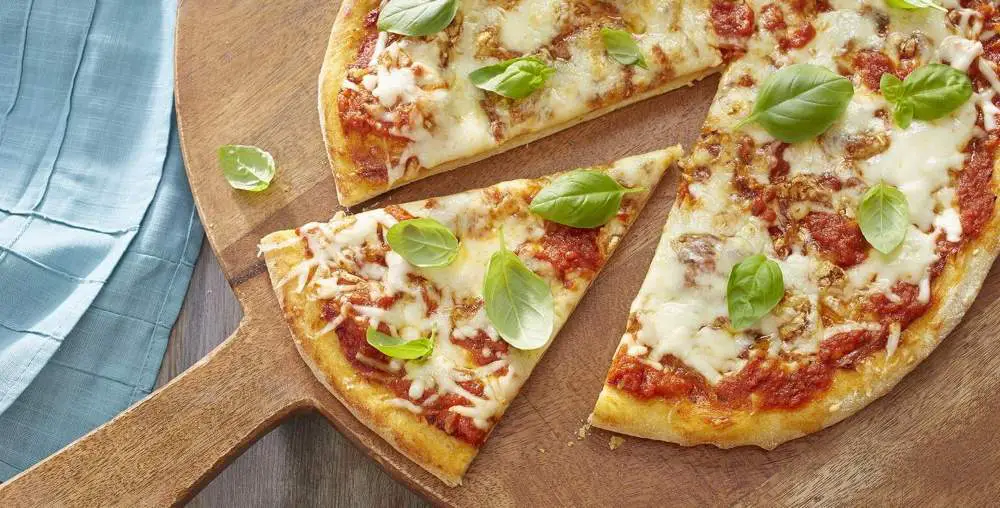
Gluten free pizza calories
Many of us think of gluten-free pizzas as the best for our health and well-being without regard to other nutrients. Sometimes this notion misleads people into thinking that gluten-free pizza is always a healthy diet without considering a ton of extra toppings.
You have to understand that first of all, gluten-free pizza is a product that does not contain wheat protein. For everything else, as far as calories and other nutrients are concerned, it is a regular food.
And as always, the caloric content depends on whether the crust is thick or thin, on the toppings chosen, and on the size of the pizza in inches, and so on. But let’s discuss the calorie content separately.
Calories: regular pizza vs. gluten-free pizza
The average slice of standart pizza crust contains about 300 calories. And in most cases, gluten-free pizza contains about 200 calories per slice. Thus, gluten-free pizza calories are lower on average.
This is of course not exact information, and it’s best to check with your pizza restaurant for more details. It all depends on the recipe they use and how they cook it.
If you want to consume fewer calories, skip the becon and sausage in favor of chicken. Veggies are also a healthier option than fatty meat, as meaty foods increase your calorie intake by up to 40 calories per slice.
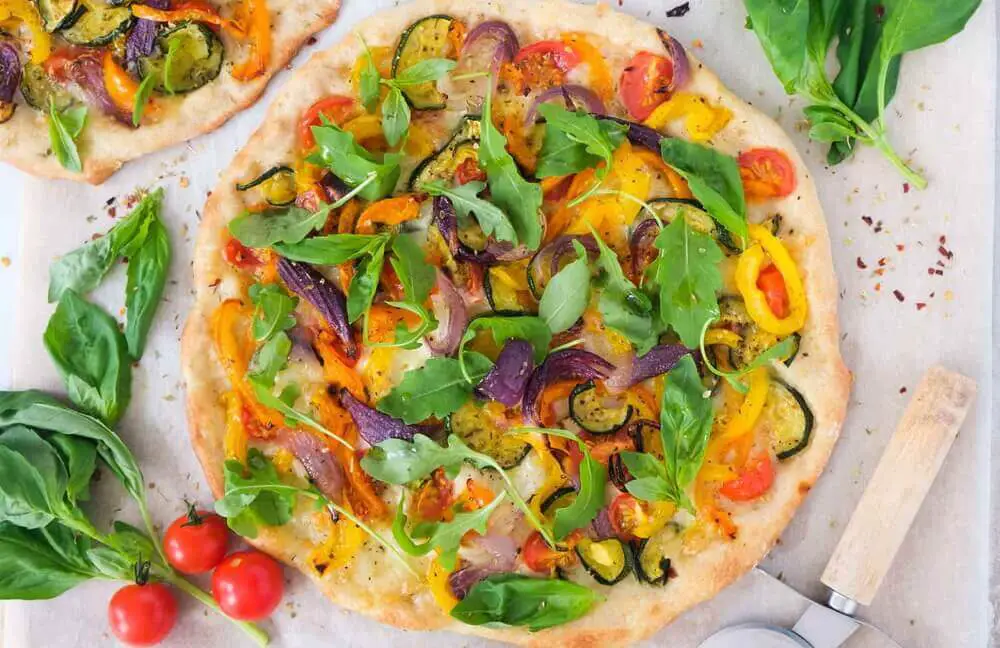
Other nutrients
Regular pizzas are not only more nutritious than gluten-free pizzas. Also, standart pizza might contain higher amounts of carbohydrates, sodium, salts, and saturated fat.
To cut down on calories, you can take half the cheese topping or order low-fat cheese. By the way, this works for both regular and gluten-free pizza. Don’t thank me!
To make your meal balanced, consume more veggies. Paprika, onions, spinach, tomatoes, basil are delicious in pizza and bring a lot of good because of the fiber and vitamin C. With healthy toppings, you can enjoy pizza more often and without the risk of extra calories.
Gluten-free pizza by Pizza Hut
Let’s compare a gluten-free pizza and a standard pizza by Pizza Hut in terms of calories per slice. Since gluten-free pizza only comes in 10 inches, so to be fair we take the other crusts in 8-inch size.
Let’s start with Meat Lover’s:
- 10 inches Meat Lover’s Gluten-Free Crust has 160 cal per slice or 1280 cal in total,
- 8 inches Meat Lover’s Small Hand Tossed pizza has 170 cal per slice or 1360 cal in total.
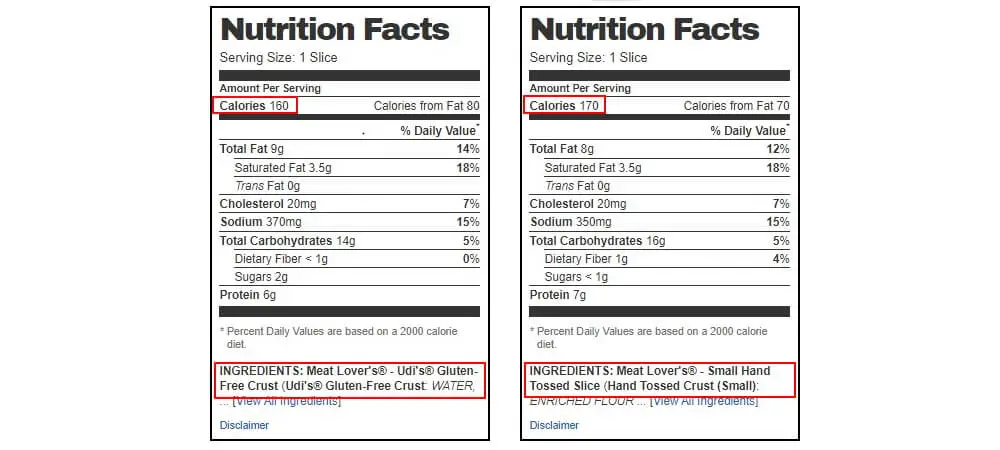
Let’s move with Veggie Lover’s:
- 10 inches Veggie Lover’s Gluten-Free Crust has 110 cal per a serving or 880 cal in total,
- 8 inches Veggie Lover’s Small Hand Tossed has 120 cal per a serving or 960 cal in total.

Gluten-free pizza by Domino’s
Let’s compare 10-inch pizzas by Domino’s:
- Ultimate Pepperoni in gluten-free crust has 410 cal per 1/3 pizza serving or 1230 cal in total,
- Ultimate Pepperoni in hand tossed crust has 260 cal 1/6 pizza serving or 1560 cal in total.
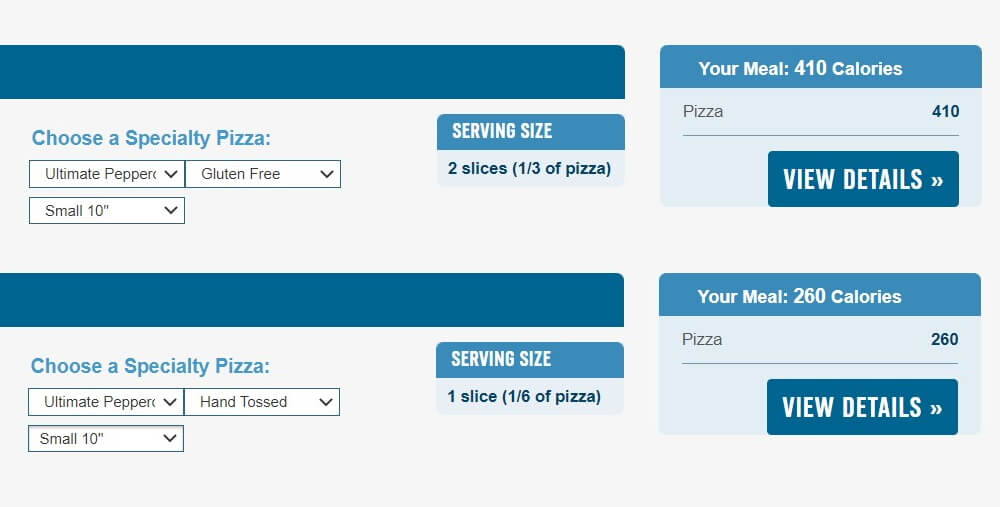
And let’s also take something with vegetables for comparison:
- Pacific veggie in gluten-free crust has 330 cal per 1/3 pizza serving or 990 cal in total,
- Pacific veggie in hand tossed crust has 220 cal per 1/6 pizza serving or 1320 cal in total.
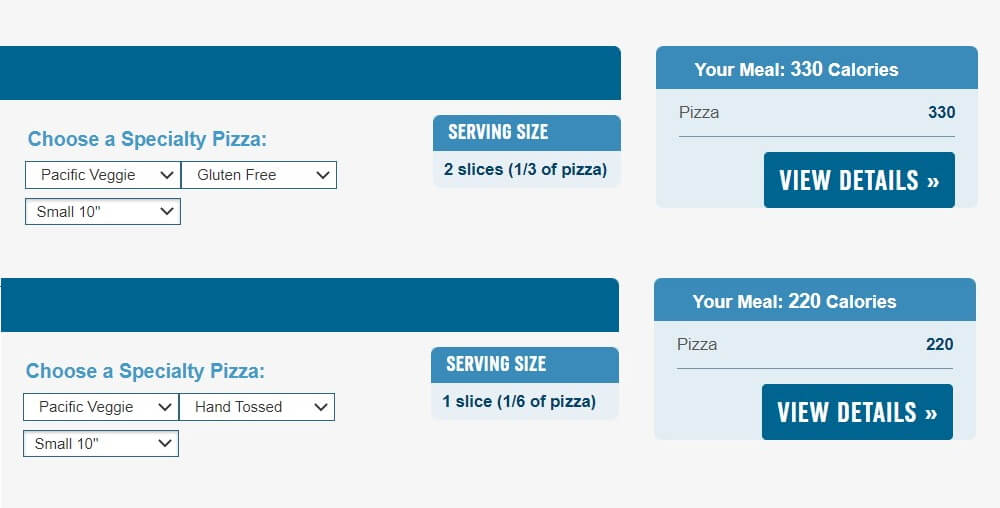
As you can see, gluten-free dough, crust option and toppings make some difference in pizza calories. So, a 10-inch gluten-free pizza has fewer calories than an 8-inch regular pizza crust.
The benefits of low calories pizza
In my humble opinion, not only do people with celiac disease follow a gluten-free diet, but they are generally more attentive to their health and less likely to be overweight. This could be the reason why eating gluten-free foods have become a popular trend.
If weight loss is important to you, eating gluten-free is a healthier pizza option. But don’t make up for the calories cut on gluten-free pizza with extra toppings. Excess meaty foods not only affect your calories, but also your extra saturated fat and sodium. Better make sure you get enough protein, fiber and vitamins in your diet.
Still, gluten-free pizza isn’t just used for gluten control, but for other benefits as well.

Preventing diabetes
The link between gluten intake and the risk of developing type 1 diabetes has recently been identified. According to The British Medical Journal, a mother’s excessive consumption of gluten can provoke the development of autoimmune disease in her child.
Scientists emphasize that this is still only preliminary results. But it is known that wheat products cause a rise in blood sugar, which for some people can turn into insulin deficiency. Gluten-free foods may help prevent the risks of autoimmune diseases. Be very careful when it comes to diabetes and be sure to consult your doctor.
Preventing autoimmune diseases
For celiac disease, a gluten-free diet is needed to keep the body functioning properly, but also gluten-free foods help avoid the development of related autoimmune diseases. In these situations, choosing gluten-free pizza is a good concern for future health.
Skin health
Sometimes the body shows allergies to gluten, although there is no genetic intolerance. For some people, it manifests as skin health problems. In this case, gluten-free pizza would certainly be the perfect choice.
Also, some people report that their skin health has improved since switching to a gluten-free diet. Here’s a dermatologist’s opinion from the Dr. Dray Channel:
General Health Concerns
Paying attention to your diet is good for your overall health. Even if you don’t have a goal of weight loss, it’s always a good idea to cut cholesterol and salts. Be aware that this will have a beneficial effect on the work of blood vessels and the heart. Cutting out extra calories and eating vegetables with their fiber is becoming a healthier pizza option.
FAQ
Does gluten-free pizza have more calories?
No, on the contrary, gluten-free pizza has fewer calories than regular pizza. Comparing the slices, a gluten-free pizza has about 200 calories, while a standard pizza has up to 300.
How much calories is a slice of gluten-free pizza?
The average slice of gluten-free pizza has about 200 calories, though of course this depends on inches, toppings, and other factors.
Are there less calories in gluten-free pizza?
Yes, it is, pizza crust made from gluten-free dough has fewer calories than regular pizza.
How many calories are in 10 gluten-free pizza?
On average, one slice of gluten-free pizza contains about 150-200 calories. For a whole 10-inch pizza, that equals 1,200 calories.
As for Pizza Hut, Meat Lover’s Pizza has 1,280 cal, Veggie Lover’s has 880 cal.
As for Domino’s, Ultimate Pepperoni includes 1230 cal, Pacific veggie includes 990 cal.

Final View on Gluten-Free Pizza
Gluten-free pizzas look like a healthier option, even if you’re not susceptible to gluten digestion and celiac disease. It’s a perfect choice for anyone who wants to reduce their calorie intake and get more healthy foods. With fewer gluten free pizza calories, it can become a part of healthy weight loss diet.
Reply in the comments, do you follow the gluten-free diet and what is the best pizza in this? Your opinion can help those who are still at the beginning of this way.
